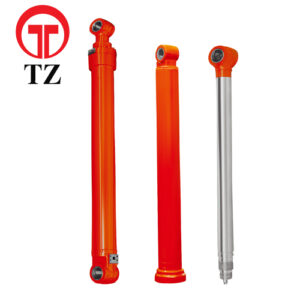To optimize the performance of excavator cylinders, several factors can be considered.
Here are some key aspects to focus on:
Proper Fluid and Lubrication: Use the recommended hydraulic fluid and ensure it is clean and free from contaminants. Regularly check fluid levels and maintain the appropriate operating pressure. Lubricate the cylinder and its components according to the manufacturer’s guidelines to reduce friction and ensure smooth operation.
Regular Maintenance: Implement a proactive maintenance schedule for the excavator cylinders. This includes inspecting for leaks, damage, or wear, and promptly addressing any issues. Replace worn seals, wipers, or damaged components to prevent fluid leakage and maintain optimal performance.
Correct Alignment and Mounting: Ensure that the excavator cylinder is properly aligned and securely mounted to the boom, arm, or other components. Proper alignment reduces stress on the cylinder and promotes efficient operation.
Cylinder Seals: The seals in the excavator cylinder play a critical role in preventing fluid leakage. Regularly inspect and replace worn or damaged seals to maintain the cylinder’s performance. Proper seal selection and installation are crucial for optimal sealing and longevity.
Control Valve Adjustment: The control valve regulates the flow of hydraulic fluid to the cylinder. Ensuring proper adjustment of the control valve can optimize the cylinder’s responsiveness and efficiency. Consult the excavator’s manual or seek professional assistance for valve adjustments.
Avoid Overloading: Operating the excavator within its recommended load limits helps prevent excessive strain on the cylinders. Overloading can lead to premature wear, reduced performance, and potential safety hazards.
Operator Training: Proper training of the excavator operator on the correct operation and handling of the machine can contribute to optimizing the performance of the cylinders. Operators should use smooth and controlled movements, avoiding abrupt or jerky actions that can strain the cylinders.
Monitor Operating Conditions: Pay attention to the operating conditions of the excavator, such as temperature extremes or excessive dust or debris. Extreme conditions can impact cylinder performance and longevity. Take necessary precautions or implement additional cooling or filtration systems when required.
Upgrades and Improvements: Stay updated with advancements in excavator cylinder technology. Newer designs or materials may offer improved performance, durability, and efficiency. Consider upgrading cylinders when appropriate or consult with manufacturers or suppliers for potential enhancements.
Regular Inspections and Testing: Conduct regular inspections and testing to assess the performance of the excavator cylinders. This can include pressure testing, leakage checks, and functional assessments to identify any potential issues before they escalate.
By implementing these measures, the performance, reliability, and lifespan of the excavator cylinders can be optimized, resulting in efficient operation and reduced downtime.
How are excavator cylinders installed and connected to the excavator?
Excavator cylinders are typically installed and connected to the excavator through the following steps:
Determine the Cylinder Requirements: Identify the specific needs and requirements for the excavator cylinder based on factors such as the excavator model, application, and desired functionality.
Choose the Right Cylinder: Select a cylinder that matches the specifications and requirements of the excavator. Consider factors such as cylinder size, stroke length, operating pressure, and load capacity.
Prepare the Excavator: Ensure the excavator is properly prepared for cylinder installation. China excavator cylinders This may involve positioning the machine on stable ground, engaging the safety mechanisms, and powering off the engine.
Identify Mounting Points: Locate the mounting points on the excavator’s boom, arm, or other relevant components where the cylinder will be attached. These mounting points are typically designed and positioned specifically for the cylinder installation.
Align the Cylinder: Align the excavator cylinder with the mounting points on the excavator. Ensure that the cylinder is positioned correctly and securely in place before proceeding.
Secure the Cylinder: Use appropriate bolts, pins, or other fasteners to secure the cylinder to the mounting points on the excavator. Follow the manufacturer’s guidelines and torque specifications for proper installation.
Connect Hydraulic Hoses: Connect the hydraulic hoses from the excavator’s hydraulic system to the corresponding ports on the cylinder. Ensure the connections are tight and properly sealed to prevent fluid leakage.
Test the Connections: After the cylinder and hydraulic hoses are connected, conduct a visual inspection to verify that all connections are secure and properly aligned. This is to ensure that the cylinder will function correctly and safely during operation.
Conduct Functional Tests: Once the cylinder is installed and connected, test its functionality by operating the excavator’s hydraulic controls. Gradually test the cylinder’s extension and retraction, ensuring smooth and controlled movement without any abnormal sounds or vibrations.
Perform Safety Checks: Before resuming regular operation, perform a thorough safety check of the excavator, including the installed cylinder. Verify that all connections, bolts, and fasteners are secure, and that there are no signs of leaks or other potential issues.
It’s important to note that the specific installation process may vary depending on the make and model of the excavator and the type of cylinder being installed. Always refer to the manufacturer’s instructions and guidelines for proper installation procedures and safety precautions. If unsure, it’s recommended to consult with a qualified technician or the manufacturer for assistance.
